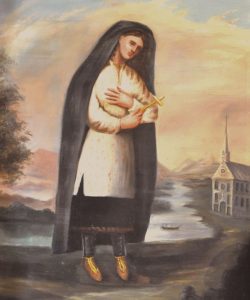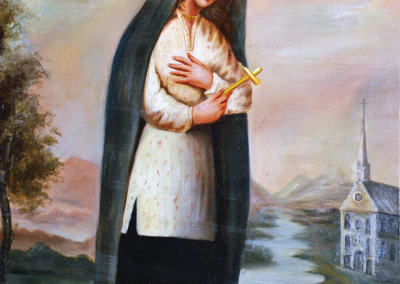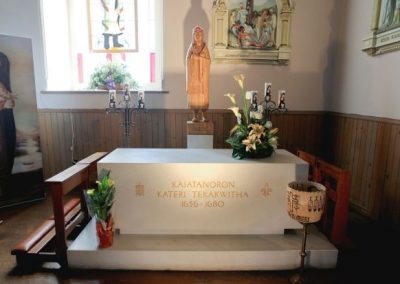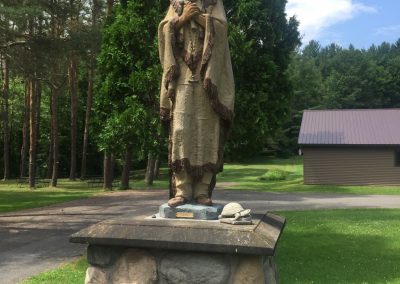Saint Kateri Tekakwitha
Birth and youth:
Kateri Tekakwitha was born in April 1656, in her father’s longhouse in the Mohawk village of Ossernenon (near Albany, USA). “Tekakwitha’s father was a pagan Iroquois, her mother a Christian Algonquin. She was educated and baptized in the city of Trois-Rivières. Her virtue was already admired when, during an Iroquois incursion, she fell into the hands of a warrior who took her captive. She won her master’s heart. Instead of making her the victim of his cruelty or libertinism, he took her as his wife” (c.f. LECOMPTE, Édouard, Catherine Tekakwitha, page 21).
We know that the name Iroquois was given to them by the French, because these natives ended all their speeches with the word Hiro (I said), adding the word Koué, a cry of joy or sadness, depending on whether it was pronounced long or short. They called themselves Hodenosaunee, meaning people of the longhouse (cf. GARNEAU, Histoire du Canada, 5th ed., Paris, 1913, t. I, p. 119).
Having had the good fortune to give birth to two children, a boy and a girl, the mother’s main desire was to have them baptized. The opportunity did not present itself” (c.f. LECOMPTE, Édouard, Catherine Tekakwitha, page 22). In 1660, a terrible plague broke out in Iroquois country. Smallpox killed Kateri Tekakwitha’s father, mother and younger brother. She herself was struck by the disease, but did not die. She was only four years old. Her face,” says Father Chauchetière, “which had been well done before, was spoiled; it was not long before she lost her sight” (c.f. LECOMPTE, Édouard, Catherine Tekakwitha, page 23). From then on, her eyesight became sensitive to sunlight. So she got into the habit of wearing a blue blanket over her head when she went outdoors. Around this time, she was given the name Tekakwitha. According to some historians, in her language, this name means “She who moves forward, who moves something in front of her”, expressing the hesitant gait of the child, whose eyes were so painfully affected by illness.
Tekakwitha’s uncle took her in under his roof. The young native’s life was spent almost exclusively inside the cabin, also known as the longhouse. After the epidemic, the village moved one mile upstream, next to Auries Creek. This later became Auriesville. The village was officially called Gandaouagué.
Tekakwitha’s uncle, his wife, one of his sisters and the little orphan girl moved into one of the new village’s main cabins, sheltered by the high palisade that protected it. “And so began for Tekakwith a peaceful, secluded life, where her natural inclinations first appeared” (c.f. LECOMPTE, Édouard, Catherine Tekakwitha, page 27). Tekakwitha, still very young, showed a sharp mind and a keen taste for work. For her, the most important thing was to get rid of her daily chores as quickly as possible. Once this was done, the girls and women gave themselves over to entertainment, visits, noisy get-togethers, games and dancing. Kateri, necessarily confined to her hut, naturally escaped this turbulent life. From then on, the love of the silent life and the inner life could germinate and grow in this heart that God had destined for Himself alone.
“In those days, there was a curious custom in Iroquois country. Families would forge bonds of friendship by offering each other a little boy or girl, often still in the cradle. They called this simple encounter marriage.
At the age of eight, Tekakwitha had been introduced to a boy not much older than herself. But she rejected all these proposals. The aunts, on the other hand, were eager to increase the family’s well-being, and saw this as a guarantee of future settlement. They were only waiting for their niece’s marriageable age to accomplish their plan. Her aunts had resolved to set a trap for her, and make her fall into it without her knowing. Their eyes fell on a young man from the village. They obtained his consent and that of his parents. They soon invited him to their cabin to perform the marriage rite with their niece. He showed up one evening, entered the cabin and simply sat down beside the young girl. After a short conversation, one of the aunts asks her niece to honor their charming visitor and offer him some sagamite. “Tekakwitha, who at first blushed when she saw this young man sitting beside her, understood the trap being set for her. Without a moment’s hesitation, she gets up and runs out of the cabin. Her resolve is absolute: she will not return until the young man is out” (c.f. LECOMPTE, Édouard, Catherine Tekakwitha, page 39).
“This was a terrible rebuff for the aunts, and a bitter affront for their host. They decided that violence alone would force the orphan to obey. A war of taunts, threats and abuse ensued. The harshest, most vile tasks were imposed on her. She was no longer the child of the family, but a slave. They even reproached her for the blood that partly ran in her veins: the blood of an Algonquin! And not the very pure, unmixed blood of the Iroquois race… (c.f. LECOMPTE, Édouard, Catherine Tekakwitha, page 40)”.
Coming of the Jesuits:
In September 1667, the Mohawk deputies left Quebec for Gandaouagué accompanied by three Jesuit priests: Jacques Frémin, Jacques Bruyas and Jean Pierron. They were delegated by the French to discuss the terms of peace with the Mohawk leaders. This took place inside newly built stockades at Tionnontogen. The absence of the Mohawks was evident as they were unable to meet with the Jesuits at the newly built village due to their previous drinking and festivities. Only Kateri and her uncle remained in the Turtle Village. The uncle, who did not care much for the Jesuits, gave 11-year-old Kateri the responsibility of looking after the three priests. The fathers were impressed by Kateri’s caring and gentle predisposition to prepare their mats, serve them food and water, and attend to their needs for three consecutive days. As the young hostess continued to provide exceptional care, their hearts were filled with admiration and delight.
Some Jesuits, who later documented Kateri’s life, viewed this unusual situation as a mystical arrangement by God, and the three priests’ witness to this innocent Mohawk girl as a reflection of Christ’s goodness. Kateri, for her part, was also impressed by the Jesuits’ serenity and commitment to prayer, which perhaps triggered a small glimmer of light from the Lord as a result of this mysterious encounter to send her a message and bring her closer to Him.
Throughout her life, Kateri always had this ability to transform the feelings of those around her. When other young people were gossiping, Tekakwitha would turn the conversation into joyful songs. Kateri Tekakwitha was so skilled and dedicated in crafting that the belts (gus-ha-ah) she made were the most sought after. Especially since she put beauty into her work, mixing dyed moose hair with basswood fibers to create colorfully patterned belts.
The young girl kept her great secret of not revealing her deep desire to become a Christian until she was eighteen years old. On April 5, 1676, Easter Sunday, she was baptized by Father Jacques de Lamberville, and given the name Catherine, in honor of St. Catherine of Siena. It is reported that on that day, the young Mohawk baptized girl beamed with joy, and looked entirely different as a result of the sacrament of baptism.
Many believe that the fervent prayers of Kateri’s mother helped prepare this special soul to ask for holy baptism. This aura of holiness, however, fanned the flames of hostility toward her among her own people, so that this obvious resentment toward Kateri became a source of concern for those who cared about her.
Refuge in Kahnawake:
News that Kateri Tekakwitha was being mistreated among her people reached the Christian village of Kahnawake in Canada, and it was decided that several men would be sent to bring the girl back to Prayer Village. Tekakwitha’s half-sister’s husband and a Huron offered to make the journey to bring her back to the missionary community of Kahnawake; however, finding a way to get her away from her fiercely protective uncle would be a difficult task. While the uncle was away, without much delay, the three of them left the village and began a long 10-day exodus of about 250 kilometers to La Prairie (in Canada). But, once he heard about this escapade, the uncle got angry, took his rifle and went after his niece and the kidnappers. Once the uncle got close to them, the worst was expected. But the angry uncle suddenly changed his mind and allowed Kateri to continue on her way. It is believed that this transformation from rage to reconciliation for his niece was just another example of Kateri’s mystical effect on those around her. The Mohawk saint still had a perilous journey ahead of her, and the toll of such an arduous journey would weaken her health and debilitate her.
After a long and thorny journey and the fear of ambush at every turn along the way, the sight of the village of St. Francis Xavier Mission was a real relief. On her journey, Kateri showed great courage in leaving everything behind and, far from the protection of her uncle, she relied on her faith in God. Once in Kahnawake, Kateri found her mother’s image in an old friend named Anastasia who was considered an aunt. Anastasia was no stranger to the Jesuit teachings and Kateri stayed by her side like a bee to a flower. Besides Anastasia, Kateri was in contact with other Christian women at the mission, with whom she developed a friendship and shared her passion for Christ. The sisterhood became large and she eventually adapted fully to Kahnawake life.
Kateri, free at last to practice her Christian faith openly and simply with other Native Christians, was eager to learn as much as she could about the Christian faith. The Jesuit priests who helped her on her spiritual journey were impressed with her rapid progress. Canada became a fertile place where Tekakwitha could get closer to God.
Living in the forest, not knowing how to read or write, would be a real challenge for her. In Montreal, apart from the large churches, she admired the nuns who worked in the hospitals. An idea took hold of Kateri and her companions to form their own community. They proposed their project to Father Jacques Frémin SJ, director of the village mission, but it was a losing proposition. Personally, Kateri was not able to make great strides in her spiritual formation, as her frail health was an obstacle. She lived her daily life without complaining about herself or others and hardly considered others responsible for her disappointments or doubts.
On Christmas Day 1677, Kateri Tekakwitha made her first communion. Father Pierre Cholenec, Kateri’s spiritual father, oversaw her instruction in the Catholic faith and her spiritual journey until he agreed to grant her the sacrament of the Eucharist without further delay, given the young Mohawk’s exceptional devotion to Jesus. Fortunately, Father Cholenec also felt it was important that Kateri’s Catholic life be unambiguous. Time being precious, and health being poor, it was necessary to hurry and Kateri Tekakwitha was beaming with happiness at the idea of finally receiving the Body of Christ, and especially on this Christmas Day! What more could she ask for than this beautiful gift! She felt fulfilled and her wish fulfilled.
Kateri’s illness and death:
With little health like hers, Kateri knew deep in her heart, that she had so little time left to fully show herself as a daughter of God and to give her best to the Lord. It was through her constant prayers and the Blessed Sacrament that St. Kateri Tekakwitha remained strong, passing through every temptation with a deep confidence that her spiritual life was dedicated to Christ.
As Kateri’s health deteriorated, all those around her did not want to leave her side for fear that she would die while working in the fields. The wakes around her on the part of the Mohawks multiplied, and the attentive Jesuit priests continually stood at her bedside. A cloud of sadness descended on the St. Francis Xavier Mission as Kateri’s last days became imminent. And so, on Holy Wednesday, April 17, 1680, Kateri breathed her last. At that moment, her face lit up and became radiant. Present at this extraordinary spiritual event, Father Claude Chauchetière, who had been suffering from depression and doubts about his vocation as a priest, experienced an inner conversion. But with the death of Kateri, his life took a decisive turn.
After Kateri Tekakwitha’s passage to the afterlife, many people came to pray at her grave, reporting numerous healings and miraculous favors attributed to this holy Mohawk. Her tomb is currently in Saint-François-Xavier Church, 1 River Road, Kahnawake, Quebec.
Apparitions of Kateri:
On Easter Monday, six days after Kateri’s death, as Father Chauchetière was beginning his regular oration at four o’clock in the morning, in his unheated room, she appeared to him resplendent as the rising sun. A voice that was not his own was heard: “Adhuc veni in dies” (which means: “Every day I appear”). Kateri stood in front of him, majestic, her face radiant with light and her eyes raised to the sky as if she were in ecstasy. This vision lasted a good two hours. Father was able to look at her at his leisure and realized to his great joy that this was her way of proving to him that the services he had rendered her were not forgotten. Kateri said to him in Latin, ‘Look and do as the model does’, so he began to paint her as he saw her. In this scene, the Jesuit is depicted in prayerful recollection, contemplating Kateri in her elevation during the apparition.
The apparition did not speak to him, but the Father clearly saw prophetic symbols on either side of Kateri. To her left, for example, he saw an overturned church, and to her right, a native tied to a pole, being burned alive. The first omen came true three years later, on August 20, 1868, at midnight.
A dreadful storm accompanied by thunder and lightning came down on the village, seizing the sixty feet long church by one angle with so much violence that it overturned on the opposite angle and was completely demolished. The sacred furniture came out intact except for five crosses which were broken. The statue of the Blessed Virgin on an eleven-foot pedestal was only knocked over.
As for the native tied to the post in the middle of the flames that Father Chauchetière had seen in the apparition, he knew his name ten years later. In August 1690, fourteen Goiogoians seized Étienne Tegananokoa, an Iroquois Huron, and his wife Suzanne, an Agnière. After much suffering, she managed to escape and return to Saint-François-Xavier. But that day, she never thought she would be free again. However, Étienne had said to her: “I am dead, I can see that, God is the master. But for you, you will have life, and so I recommend that you always persevere in the fear and service of God. This is all I ask of you, and if you grant me this, I will die happy” (c.f. Kateri, Lys des Agniers, no. 81, summer 1980, pages 16 to 18). After suffering horrific torture, Stephen was burned alive for being a Christian.
Étienne Tegananokoa was not the only martyr of the Saint-François-Xavier Mission. Kateri,” writes Father Cholenec, “had predicted the glorious death of some of the Christians of this Mission long before it happened, and it is to be believed that it was she who, from Heaven where she was placed, sustained the courage of these generous faithful, who showed their constancy and their faith in the most terrible torments…”. In 1692, an Onnontaguée, Françoise Gonannhatenha, perished in the most atrocious tortures in her native village and was followed the next year by one of her compatriots, Marguêrite Garongoüas with her son still at the breast, and finally by a young Agnier, Étienne Haonhouentsiontaouet, around 1693 (c.f. Kateri, Lys des Agniers, no. 81, Summer 1980, page 18).
The miraculous painting of Saint Kateri:

Miraculous Painting of Kateri, by Father Claude Chauchetière
On September 1, 1681 and April 21, 1682, Kateri granted Father Claude Chauchetière new apparitions. In these last two, she appeared to him glorious as a noonday sun and he heard these words: “Inspice et fac secundum exemplar” (which means: “Look and do…according to the model” (Exodus 25:40). Father Claude was somewhat of an artist and he understood that the Lord wanted him to paint images of Kateri. This he did, despite the fact that the idea had been resisted by many people up to that point. The happy effect of these portraits of the Iroquois girl exceeded all the missionary’s expectations. She quickly became popular throughout New France as she became miraculous. The image was placed on the head of the sick and it brought about extraordinary cures, even miracles (c.f. Kateri, Lys des Agniers, no 81, summer 1980, page 20).
Sources:
-Diego PAOLETTI, Catherine Tekakwitha
-Father Édouard Lecompte, S.J., Catherine Tekakwitha
-Kateri, Lys des Agniers, no 81, summer 1980






